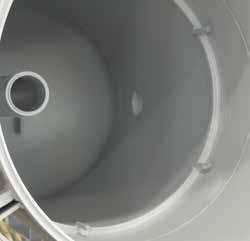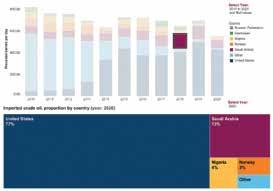
3 minute read
Saskatchewan’sheavy oil zone
PTRC investigating the utilization of CO2 extensively in Saskatchewan’s heavy oil zone
Matt Nasehi, the manager of operations at the Petroleum Technology Research Centre, has seen the nature of heavy oil research and development change fundamentally in the last twenty years.
“When PTRC was formed,” he says, “we were provided with a couple of main directives – to improve the recovery of oil from heavy oil in the province, which was averaging less than seven per cent of the oil-inplace, and lessen the environmental footprint of that oil production through new technologies that use less energy, water and other resources.”
The first few years of research at PTRC, starting in 1999, focused definitively on those two goals, but then a funny thing happened on the way to the forum, so to speak.
Pan-Canadian, then the operators of the Weyburn oil field in southeastern Saskatchewan (nowhere near the heavy oil fields along the border with central Alberta) decided to start injecting carbon dioxide into their depleted oil wells to increase production. That fateful decision altered the direction of research at the PTRC.
“It was an interesting transformation that resulted from the Pan-Canadian decision, and from the interest it raised in both the PTRC and among government and researchers,” says Nasehi. “The subsequent 15-year research program helped establish Saskatchewan as a centre for carbon dioxide utilization and storage – yes, for enhanced oil recovery, but also for emissions reductions.”
PTRC would go on the develop a second CO2 storage project, Aquistore, which is discussed in another article in this edition of the Saskatchewan Oil Report, but with the rising interest in CO2 storage and utilization around the world, research into uses for such emissions has continued to grow. It was only a matter of time before PTRC decided to wed its interest in heavy oil research with CO2 utilization. The result is a planned program in injecting carbon dioxide from existing sources in the heavy oil zone into the oilfields underground.
With the publication this past October of a white paper called CCS Potential in the Heavy Oil Regions of Saskatchewan and Alberta, PTRC is positioning itself to be the research leader on this topic (see: https://ptrc. ca/pub/docs/OfficialWhitePaper%20 Final.pdf).
“With the recent completion of the Alberta Carbon Trunk Line to centre Alberta,” says Nasehi, “there may be ample opportunities for stretching that pipeline to the Lloydminster area and other sources there adding to the supply, for possible storage and utilization in and below the heavy oil reservoirs.”
PTRC is in the developmental stages of a research consortium into expanding CO2 use in the area. Researchers at both University of Regina and the Saskatchewan Research Council have already been funded by PTRC to conduct work into cyclic solvent injection in the Lloydminster area.
“I think utilizing much of the emissions from heavy oil production in Western Canada is a very real possibility going forward.” v



CONSTRUCTION & MAINTENANCE SERVICES
MECHANICAL: ■ Fabrication of the following piping: • Carbon Steel, Stainless Steel & Chromoly Piping • Threaded Piping • HDPE & Fiberglass Piping ■ Blasting & Painting ■ Hydrotesting ■ Torqueing ■ Vessel Modifications ■ Equipment Installations ■ Demolition STRUCTURAL: ■ Cutting & Capping of Piling ■ Fabrication & Installation of the following: • Structural Pipe Racks • Stairways & Landings • Safety Ladders • Platforms • Stiles ■ Equipment Bases ■ Torqueing ■ Blasting & Painting ■ Demolition CIVIL: ■ Excavations, Backfilling & Gravelling ■ Concrete Framing & Placement for: • Tank & Equipment Bases • Concrete Pile Caps • Concrete Piling ■ Grouting (Cementitious and Epoxy) ■ Demolition MISCELLANEOUS: ■ Plant Turnarounds & Maintenance ■ Hot Shot Services ■ Safety Services









